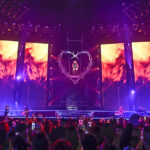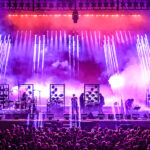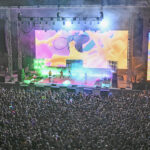It starts with “Hello” and ends with “Rolling in the Deep,” and in between is enough music, lighting, and video to sell out the world’s biggest arenas for consecutive nights. “I think the real success of this show is that the line between lighting, video and scenic is very blurred,” says lighting designer Patrick Woodroffe. “You are never quite sure what you are seeing and this very much plays into the aesthetic around which the whole show is created.”

For Woodroffe, this is his first time working with Adele, and he points out it’s actually only her second proper tour involving any major production elements. “So she’s still relatively new to the process, and that has been incredibly refreshing for all of us who have done so many [big] tours in the past,” he says. “She saw things very clearly, and her visual opinions was untainted by anything that had come before. That’s unusual and gave the whole creative team real freedom to express themselves.” As Adele, who turned 28 on May 5, ably led the creative process coming to the table with a clear vision and aesthetic, during rehearsals it evolved into a genuinely collaborative process with creative director/set designer Es Devlin providing overall direction of the big picture. The video content producer was Lizzie Pocock and Luke Halls was video content designer. “All their work was wonderful enigmatic and ethereal at times, and then others quite gritty and real,” says Woodroffe. “It was clear from the beginning that this was to be an elegant, timeless show, with much of the dynamic coming from the video content.”
Creative Technology (CT) supplied the video, whose team was led by Andy Joyes. There was an upstage LED screen measuring 22.5 by 8 meters (74 by 26 feet), and a total of 13 projectors. These included the Panasonic 20K projectors that brought the 14-meter-high (46 foot) B stage tower projection to life. Tour director Matt Askem used five HD cameras fitted with long lenses and Photon Media services, flipping the images 90 degrees to project I-Mag of Adele as she performed. These larger-than-life visuals, projected onto four roll-drop screens of white voile surrounding the four-sided tower, are considered by some to be the highlight of the show.
Neg Earth supplied the lighting and rigging for the shows in the U.K., which ran from Leap Day (Feb. 29) through June 25, and Upstaging is doing the honors here in the States. (The North American tour, which includes shows in Mexico and Canada, runs July 5-Nov. 21).

Arena-Sized, yet Intimate
Roland Greil started in this business at the bottom of the road case pulling out cables and connecting them, working his way up the food chain as one does. Since the early 2000s, he’s been designing, and about ten years ago, he started working with Woodroffe on various projects. He programs for him, contributes to the designs, and usually, as in this case, goes out on the road with the artist as the lighting director. He describes the show as being a “crossover,” as it features elements of a theater design with a lot of elements of rock ‘n’ roll, and even some television. “What we needed to do is create a picture frame for a stunning artist, and we did it by making sure that I-Mag, lighting and sets came together, and that none of those single elements worked against each other, which can happen sometimes in big productions like this.”
The 21 musicians are present, but visually in the background, especially in the beginning. On the third song, there’s a big reveal where they are more prominent, “and we reveal the whole stage with all the musicians,” Greil says. “Later in the set, there is a lot of layering happening, gauze and projected video, and the band is always present.”

Woodroffe confirms what Adele has repeatedly confessed publicly: she is terrified of performing live. “It seems odd when you see how engaged with the audience she is and I think that she has gradually overcome those fears as she does more shows,” he says. “But the intimacy she brings to her performance is from her own connection with the audience rather than the way that her production is staged. She has this amazing ability to make contact with every single person in the room and that helped us because it meant that we could still make a big statement or grand gesture in a number, knowing that she would be able to bring that intimacy with her audience right back again as soon as the song finished.” The mood-setting looks and backlighting contribute to the show’s overall vibe.
“What we’re trying to achieve is an intimate setting, where the production doesn’t overwhelm her on stage, and as she has such a good character and stage presence, that is was what makes it work,” adds Greil. There are two main positions on the main stage where she stands for the vast majority of the show, and then she spends 30 percent on the B stage in the middle of the audience. “As she stands still for most of the show, it gives you a lot of room to really play with key lighting, and it is very defined and interesting. I think we all learned a lot in the three weeks of rehearsal, and were really able to refine the specific key lighting aspects of the show, which really makes the whole thing work. Also, we worked with her ‘corporate identity’ in the sense that we wanted the I-Mag to recreate the pictures of her on her album artwork.” He observes that while she is an untouchable artist with a stunning voice when she is singing, “in between songs, when she interacts with the audience, she’s the girl next door. She brings everybody in.” It is certainly true — and, in keeping with that intimate feel, she speaks when she feels like it as long as she feels like it. This begs the question — is this a challenge for the person at the board? “After doing 70-plus shows in total at this point, you really develop a feeling for when she wants to [talk to the audience]. It does make it exciting, because every night is different, and you have to react to what she does on stage. The musical part of the show is well choreographed, so the interacting makes you need to be quick with the brakes and directing the followspots.”
Surprisingly, the show is not timecoded. “If there’s a chance to avoid [doing that], we do,” Greil says. “We’re working with a live band, and they play a little different every night, and that’s what makes the music groove. It’s always better to do without timeoding, in our opinion.” He operates with an In-Ears Monitor (IEM) system with the band and is cued into the click track.

The Look, the Tools
The show is also notable for what it doesn’t have. “Adele’s not really a pyro sort of act,” Woodroffe says. That did not keep Devlin from creating a beautiful moment for “Fire to the Rain,” however. There, Adele stands alone on a stage in the middle of the hall surrounded by four sides of rain in what is another visual highlight not soon forgotten by anybody lucky enough to attend the show. “That’s as close as we get to a special effect, and it’s one that is magical,” Woodroffe says. Another emotional moment involves the reveal of a V-shaped gauze that follows the line of the front of the stage set and that can be flown in or out. It’s a very fine weave and is a beautiful material to bleed through to reveal not just the musicians behind, but also the LED screen at the very rear of the stage.
Woodroffe made the decision at the onset to not use any saturated color in the show, save for a spot during the song, Skyfall. “Like many other lighting designers I suspect, I love white light,” he says. “There is such an authenticity to seeing something lit as it was created without layering a different color over a piece of scenery or an artist. Of course there is real theatricality to a white light show too but it just feels more real to me. We had so much variation with the gauzes and the LED screens and the film material that played on them that we never found ourselves running out of ideas, even with that limited color palette. Then when we did make a choice about using strong and saturated color— as we did in ‘Skyfall’ for example — then, of course, it has huge impact.”

To achieve it all, Woodroffe says, “the Robe BMFL’s were the workhorse for the show, along with some Viper Performance spots and VL3500s.” Other tools he used include a number of Ayton MagicBlade-R fixtures, Clay Paky Sharpys and the new Clay Paky Scenius. “I’m of a generation that is still incredibly impressed by whatever I’m given to work with!” he laughs. “The fixtures that we designers are constantly being offered from all the suppliers just get better, faster, brighter, and smaller. I cannot say enough how grateful we all are to have our view of the horizon constantly widened and our imaginations stretched by the tools we now have at our disposal.”
“The Scenius is a completely new unit, and I think we’re one of the first productions to really use it,” Greil adds, noting that they’ve got 70 on the tour. “We saw this fixture last year and got curious about it.” It’s used to light up the audience and is one of the main keylighting fixtures for Adele used on the show. As for the MagicBlade-Rs, he says Woodroffe wanted to create a symmetrical lighting grid, and the Robe BMFLs and Blades offered the overall look he wanted. “Every MagicBlade holds seven LEDs, so that’s a lot of light bulbs, and it becomes this wonderful ceiling of lights.” Greil is operating “two and a half” grandMA2s.
The B stage in the center of the auditorium is also surrounded with gauzes that magically appear and disappear as the set unfolds. And careful observers will note that, when looking at that B stage, there’s no clunky FOH platform to get in the way. Devlin wanted to avoid that “big lump in the middle of the audience,” so lighting and audio is snugly positioned to the side. This allows for more members of the audience to get closer to her as that B stage rises, with nary a visual obstacle. “It was something new for all of us, but it has worked out very well and is perfect for the show,” Greil says. Video monitors strategically placed allow Greil to get that crucial center point of view. Of course all the stops are pulled out for the final finale — “Rolling in the Deep.” “You want to end on a high note with a big production number, and this song is the most rock ‘n’ roll style of the show,” Greil says. “There’s a lot of strong lighting looks, and Quantum’s confetti comes out in the middle, and we bring up the house lights — it really sends people home on a high note.”
“It’s really quite a simple show, although it took a huge amount of work to make it appear so,” Woodroffe sums up. “Every lighting cue, every frame of film and every scenic movement was carefully considered and crafted to work not just in harmony with each other but also as a perfect complement to whatever Adele is singing or saying at the time. I love it all. Each part of the show unfolds gently and elegantly, constantly revealing another part. I never tire of watching it.”

Crew
- Production Manager: Richard Young
- Creative Director/Set Designer: Es Devlin
- Lighting Designer: Patrick Woodroffe
- Associate Lighting Designer: Adam Bassett
- Tour LD/Programmer: Roland Greil
- Lighting Cos: Upstaging (North America), Neg Earth (Europe)
- Crew Chief: Chris Davis
- System Tech: Luke Radin
- Dimmers: LC Proudette (North America), Jim Mills (Europe)
- Lighting Crew: Ricky Krohne, James Fredrickson, Ray Castro (North America), Jamie Gorman, James Fredrickson, Sarah Janebrink (Europe)
- Video Co: Creative Technology (CT)
- Video Crew Chief: Andy Joyes
- Video Tour Director: Matt Askem
- Video Content: Lizzie Pocock, Luke Halls
- Special FX: Quantum Special Effects (Confetti & Rain)
Gear
- 2.5 grandMA2 consoles
- 94 Robe BMFL Spots
- 94 Ayrton MagicBlade-Rs
- 70 Clay Paky Scenius fixtures
- 16 Clay Paky Sharpys
- 27 Martin MAC Viper Performances
- 16 Vari-Lite VL3500 Washes
- 27 Color Kinetics iWhite fixtures
- 38 Mole-Richardson 2-Lite Molefays
- 4 ETC Source Four Lustr 2 fixtures
- 3 MDG theONE hazers
- 1 Upstage LED screen (22.5 x 8 meters)
- 13 Projectors (incl. Panasonic 20K units)
- 5 HD cameras w/ long lenses
- 4 Roll-drop screens of white voile
- V-shaped and other gauze elements


